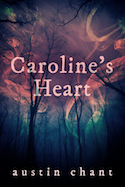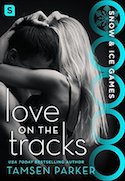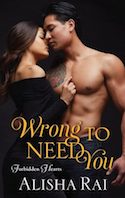Kissing Books: series-ously speaking...
New Column! Every month, Olivia Waite pulls back the covers, revealing the very best in new, and classic, romance. We're extending a hand to you. Won't you take it?
This month’s books are heavy on new and continuing series, so it’s a good time to look at how series work in romance.
Romance series, like mystery series, tend to be chains of standalone episodes. While the Fifty Shades phenomenon has made single-couple trilogies briefly A Thing (and in my humble opinion, A Super Boring Thing), more commonly each romance in a series will show one specific happy ending per book—meaning the reader who’s missed the first one or two can still jump in with book three and have a reasonably good time. As distinct from a lot of fantasy and sci-fi series, where plot and character tend to accumulate as a series grows in length; much as I love Ann Leckie’s Imperial Radch books, I would never recommend a reader leap right into book three without reading the first two volumes.
This structure also means that savvy romance readers will start the series on the watch for heroes and heroines of future books. Hence the term sequelbait, referring to a secondary character who will probably (or hopefully) get their own complete romance in volumes to come. Best friends, siblings, ex-lovers, and occasionally even the villain can nab the romantic spotlight, as we saw with last month’s Mary Balogh. Occasionally this goes very wrong, as when Gena Showalter announced that the popular couple she’d been teasing for eleven books would not actually end up together, leaving readers feeling manipulated, betrayed, and exploited for cash. Occasionally, though, authors can use those same expectations to set up a grand and glorious punch to the heart. I’ll never forget the delicious shock Zoe Archer pulled off in her underrated Hellraisers trilogy: four dissolute aristocrats in Georgian London sell their souls to the Devil, fall in love, have a moral awakening, and fight to break the contract. Four heroes, but only three books, because she flat-out killed off one of the sequelbait—for very solid story reasons, so that after the initial surprise there was only the rush of satisfaction and Ah, yes, should have seen that coming. It was a bold and brilliant move, and it still leaves me breathless to think about.
The great thing about sequelbait is it suggests that, in theory, anyone can be a heroine. Side characters are not less important overall, they are merely less central from a limited perspective. Everyone has the potential for a happily ever after. In practice, however, sequelbait is often identified because the markers of romance hero- and heroine-dom can be very narrowly defined: young, cis, white, thin, able-bodied, and straight. It’s not changing as fast as many of us could wish. Whole sections of romance refuse to allow queer characters at all (looking at you, inspirational romance). Romantic suspense author Suzanne Brockmann has received much vocal praise for including gay romance arcs in her popular Troubleshooters series; she has also received plenty of critique from queer romance authors and readers pointing out that she includes those arcs as secondary novellas and subplots, supplemental stories rather than full standalone books alongside the straight couples. Meanwhile a known chunk of m/m readers will flat-out refuse to read anything with m/f sex on the page at all, with suppressive results on the number of bisexual characters in romance, even from queer-friendly publishers.
The series whose books we see below are pushing back against much of this. Alisha Rai’s Wrong to Need You, second in her beautifully soapy Forbidden Hearts trilogy, features a bi heroine in a matter-of-factly diverse town. Tamsen Parker’s Snow and Ice Games series promises both an m/m and f/f couple in future books; the first one is a lively adrenaline rush perfect for winter reading. Cat Sebastian begins a new m/m historical series, Seducing the Sedgwicks, with a gorgeous, thoughtful take on a high-concept premise, and a vicar hero whose sexuality is never at odds with his faith, only with society’s denial of it.
Happy reading!
Recent Romances:

Caroline’s Heart by Austin Chant (self-published: trans m/trans f Western fantasy)
Fantasy romance, like all fantasy, lives and dies on how deeply the reader can sink into the made-up world—and oh, how easy it was to tumble into this one. All the weight and swelter of a hot Texas summer (plus magic!) grabs you on page one and never lets go. Hero Roy is wry and weathered and loveable as only a soft-spoken cowboy can be. He says ma’am a lot, which I know will appeal to plenty of readers. As a trans man, Roy’s learned to keep himself to himself and stay far away from trouble, so of course he ends up risking his life to save a pretty trans witch in the middle of a saloon brawl. Cecily, our witch, makes magical prosthetics (hands, spines, etc.); she is lonely but prickly and her great ambition is to bring back her girlfriend back from the dead. Roy’s cure requires her to give up a precious object she’d been hoping to use for the resurrection spell, and the rest of the novella is about the achingly sweet progression of two heartsore people coming to care deeply for one another. It’s a lovely and rare piece of work, not least because of the beauty of the love scenes, which with two trans characters come with more risk and vulnerability built in from the start, making the rewards feel that much sweeter. This is a shout it from the rooftops kind of recommendation. Do not miss this one.
The human body is a complexity of anchors and pulleys, but Cecily has devoted herself to understanding it, tailoring the tension and slack of each spell-thread until the prosthetic leg can bend and stretch gracefully.

Love on the Tracks by Tamsen Parker (Macmillan: contemporary m/f):
Tamsen Parker’s first book was an erotic romance with an Orthodox Jewish heroine—so you know she’s an author who’s always up for a high-concept challenge. Love on the Tracks, first in the Snow and Ice Games series, features a boy-band star singer and a gold-medal hopeful in women’s luge: their cute publicity photo-op goes viral and they start fake-dating to milk the momentum. And then: real feelings! Complicated by the intense and neverending pressure to perform, the ambitious career drive, the lack of time and privacy for anything like a social life, and the machinations of a meddling manager and an obsessively overprotective father. Plus the real risk of death in competition for our heroine. This book has a great many pleasures: the adrenaline rush of high-stakes competition, the peek at pop songcraft, the fact that heroine Rowan is the hard-bodied, cut, muscular one and hero Zane is the one most often described as pretty. Zane is also the emotionally tuned one—he’s an expert at riding out the ups and downs of his bandmates’ moods—while Rowan is cagey about feelings but completely physically uninhibited. It’s a fun mix: the banter is gentler and less antagonistic than The Cutting Edge (my sports romance all-time high-water mark) but there’s still plenty of drama to keep the pages turning. Sweet and sensual as good hot chocolate, with a lovely bright peppermint spike.
What she’s doing, a simple but pretty harmony, hits something in my soul. Like a cold glass of lemonade on a hot summer day, it shouldn’t be remarkable—how many glasses of lemonade have you had in a lifetime?—but there’s something about it that will remain with me for the rest of my life.

Wrong to Need You by Alisha Rai (Avon: contemporary m/f):
While I believe the definitive review of this phenomenal book has already been written, allow me to add a little something to the conversation: BJIFDSJBKDSBJKADVBJAVBJKAVKBJ!!!
… Alright, let me add a bit more. Christmas night I arrived home from a day full of dinner with good friends and excited puppies and some exhaustingly painful family drama. I felt achey and chilled, and a tenderness in the throat warned I was coming down with the vicious flu that’s been going around. Bed was a siren song. All I wanted was to read a chapter or two of something distracting while the cold sheets warmed up.
You see where this is going. Sore throat, exhaustion, even the soporific warmth of the mini-dachshund snuggling up against me like a living hot-water bottle—all these fell away under the spell of a true page-turner. I did not stop reading until that last chapter was finished. If the third book had been available, I’d have kept right on reading. Sadia’s desperate struggle to do her best as a mother, as a boss, as a widow—Jackson’s careful self-protection and paralyzing shyness, the dangerous shards of old pain too long carried—the electric spark and sizzle of the love scenes—the atmosphere of old secrets dusted off and new chances taken up—it’s the finest, sweetest melodrama we’ve seen in a very long time.
Nights like this are what I read romance for. Books like this are why I read Alisha Rai.
Her wardrobe had slowly evolved to clothes she could wash and wear and could be easily mixed and matched. It was more efficient, and she had tried to become as efficient as humanly possible. She wielded lists and journals and pens the way other people might wield swords.

It Takes Two to Tumble by Cat Sebastian (Avon Impulse: m/m historical):
A queer Regency Sound of Music—you’re either already in or already pulling the emergency escape handle. Me, I can never get enough stern, brooding sea captains in my fiction (Wentworth, Ahab), and when you add in the promise of an adorable vicar hero I am sold. Of course, stern Captain Phillip Dacre has a vulnerable side, and the playful vicar Ben Sedgwick secretly craves order and comfort and stability. It’s not a new recipe, but it sings in the hands of an artist. This book gets off to a somewhat rickety start, but only until the reader realizes that this book has one of the most disorderly worlds a romance has seen in a long while. Landscapes shift with a thought, servants and children and gentlemen are dragons and devils and princes, the hands of the clock speed and slow in mischievous, irregular ways. It’s all officially metaphorical, of course—except that it’s everywhere between the eye and the story, a lens that keeps shifting like a kaleidoscope with the characters’ mood and memories. The literary term is pathetic fallacy—and we even have a Romantic poet character around to blame it on—but analysis aside it really feels as if there is something quicksilver and alive at the heart of this book that refuses to be pinned down to commonplace realism.
Peace, Ben knew, was a series of small things, each insignificant but together making landmarks for a life.
This Month’s Cross-Dressing Heroine

Lady Rogue by Suzanne Enoch:
One of the more fascinating tropes in historical romance is the heroine in breeches, or cross-dressing heroine. (Cross-dressing heroes, while not unknown, are much rarer.) It’s very much in the Shakespearean comic tradition—women dressed as boys, trading witty banter, falling in love with men while knowing that male attire prevents the romance from ever being acknowledged. Done poorly, this trope can shore up harmful gender essentialist stereotypes: the ‘she couldn’t hide her essential female nature’ kind of book. Done well, it can be playful, subversive, even edgy—trans-adjacent, if not precisely trans-inclusive. And of all the cross-dressing heroines I’ve read, Suzanne Enoch’s Kit Brantley remains my favorite.
Kit (née Christine) is the child of a down-and-out nobleman turned smuggler for the French: she’s been raised as a con artist, a pickpocket, a thief, and has dressed and lived as a boy for the past ten years. She’s scrappy as hell. Her father deposits her with the Earl of Everton ostensibly to keep her safely in London during Napoleon’s sudden return to power, but really Kit’s job is to find out which meddling peer has been messing up their smuggling operations. Naturally, it’s the earl himself; naturally, he and Kit fall in love.
This trope often has the hero spend long chapters agonizing over his attraction and fretting, as Mindy Hung put it for the Toast, “am I a gay?”. This book plays no such games. Everton figures out Kit’s disguise on page 15, a day after they meet, and the truth makes him and Kit co-conspirators in a delightful, mischievous way. Kit gets a new exquisitely tailored masculine wardrobe—to her great delight—makes fast friends with Everton’s cronies, and generally swans about charming Society and making all the girls swoon over how handsome she is. Everton’s mistress figures out the truth and jealously begins blackmailing the earl, a threat which will ring familiar to anyone who knows how someone’s transness can be attacked in real life by bigots and the unscrupulous. In between blackmail, familial betrayal, and international espionage Kit begins exploring what it would mean to live openly as a woman: it’s something part of her yearns for, even though it is unfamiliar, uncomfortable, and downright frustrating. She makes a beautiful woman—of course she does—but while Christine Brantley is a more socially acceptable identity, the book takes care not to erase or invalidate Kit’s self as Kit. A few lies are told to make Society happier with the transition, but it’s Kit who charms Everton, breeches and all.
He watched as she strolled off in the direction of the punch bowl. The fact that she knew no one in the room, and almost nothing about the blue-blooded society she found herself in, presumably had no effect on her. Apparently Kit Brantley was afraid of nothing. And though that, too, brought into question her reasons for seeking him out, he couldn’t help the smile that touched his lips. She was afraid of nothing, that was, other than whether her cravat was de trop.